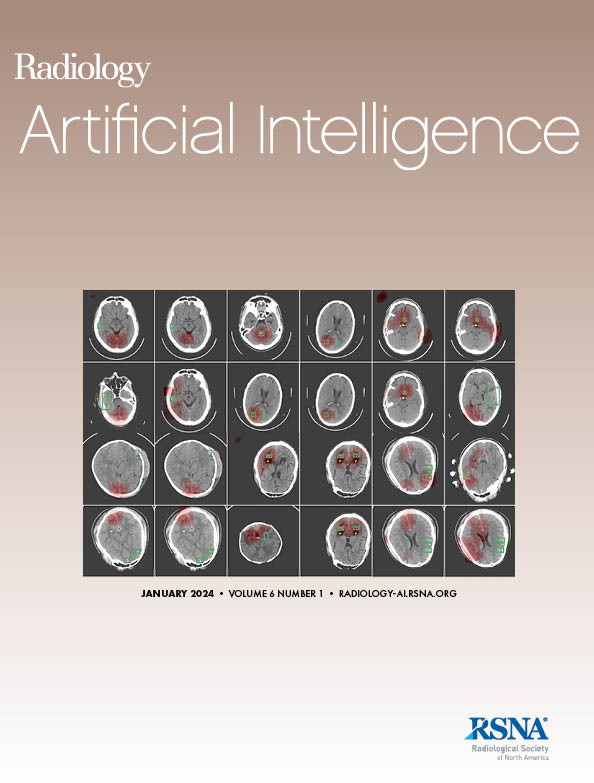Alexander S Giuffrida, Sulaiman Sheriff, Vicki Huang, Brent D Weinberg, Lee A D Cooper, Yuan Liu, Brian J Soher, Michael Treadway, Andrew A Maudsley, Hyunsuk Shim
下载PDF
{"title":"NNFit: A Self-Supervised Deep Learning Method for Accelerated Quantification of High-Resolution Short-Echo-Time MR Spectroscopy Datasets.","authors":"Alexander S Giuffrida, Sulaiman Sheriff, Vicki Huang, Brent D Weinberg, Lee A D Cooper, Yuan Liu, Brian J Soher, Michael Treadway, Andrew A Maudsley, Hyunsuk Shim","doi":"10.1148/ryai.230579","DOIUrl":null,"url":null,"abstract":"<p><p>Purpose To develop and evaluate the performance of NNFit, a self-supervised deep learning method for quantification of high-resolution short-echo-time (TE) echo-planar spectroscopic imaging (EPSI) datasets, with the goal of addressing the computational bottleneck of conventional spectral quantification methods in the clinical workflow. Materials and Methods This retrospective study included 89 short-TE whole-brain EPSI/generalized autocalibrating partial parallel acquisition scans from clinical trials for glioblastoma (trial 1, May 2014-October 2018) and major depressive disorder (trial 2, 2022-2023). The training dataset included 685 000 spectra from 20 participants (60 scans) in trial 1. The testing dataset included 115 000 spectra from five participants (13 scans) in trial 1 and 145 000 spectra from seven participants (16 scans) in trial 2. A comparative analysis was performed between NNFit and a widely used parametric-modeling spectral quantitation method (FITT). Metabolite maps generated by each method were compared using the structural similarity index measure (SSIM) and linear correlation coefficient (<i>R<sup>2</sup></i>). Radiation treatment volumes for glioblastoma based on metabolite maps were compared using the Dice coefficient and a two-tailed <i>t</i> test. Results Mean SSIMs and <i>R</i><sup>2</sup> values for trial 1 test set data were 0.91 and 0.90 for choline, 0.93 and 0.93 for creatine, 0.93 and 0.93 for <i>N</i>-acetylaspartate, 0.80 and 0.72 for myo-inositol, and 0.59 and 0.47 for glutamate plus glutamine. Mean values for trial 2 test set data were 0.95 and 0.95, 0.98 and 0.97, 0.98 and 0.98, 0.92 and 0.92, and 0.79 and 0.81, respectively. The treatment volumes had a mean Dice coefficient of 0.92. The mean processing times were 90.1 seconds for NNFit and 52.9 minutes for FITT. Conclusion A deep learning approach to spectral quantitation offers performance similar to that of conventional quantification methods for EPSI data, but with faster processing at short TE. <b>Keywords:</b> MR Spectroscopy, Neural Networks, Brain/Brain Stem <i>Supplemental material is available for this article</i>. © RSNA, 2025.</p>","PeriodicalId":29787,"journal":{"name":"Radiology-Artificial Intelligence","volume":" ","pages":"e230579"},"PeriodicalIF":13.2000,"publicationDate":"2025-03-01","publicationTypes":"Journal Article","fieldsOfStudy":null,"isOpenAccess":false,"openAccessPdf":"https://www.ncbi.nlm.nih.gov/pmc/articles/PMC11950874/pdf/","citationCount":"0","resultStr":null,"platform":"Semanticscholar","paperid":null,"PeriodicalName":"Radiology-Artificial Intelligence","FirstCategoryId":"1085","ListUrlMain":"https://doi.org/10.1148/ryai.230579","RegionNum":0,"RegionCategory":null,"ArticlePicture":[],"TitleCN":null,"AbstractTextCN":null,"PMCID":null,"EPubDate":"","PubModel":"","JCR":"Q1","JCRName":"COMPUTER SCIENCE, ARTIFICIAL INTELLIGENCE","Score":null,"Total":0}
引用次数: 0
引用
批量引用
Abstract
Purpose To develop and evaluate the performance of NNFit, a self-supervised deep learning method for quantification of high-resolution short-echo-time (TE) echo-planar spectroscopic imaging (EPSI) datasets, with the goal of addressing the computational bottleneck of conventional spectral quantification methods in the clinical workflow. Materials and Methods This retrospective study included 89 short-TE whole-brain EPSI/generalized autocalibrating partial parallel acquisition scans from clinical trials for glioblastoma (trial 1, May 2014-October 2018) and major depressive disorder (trial 2, 2022-2023). The training dataset included 685 000 spectra from 20 participants (60 scans) in trial 1. The testing dataset included 115 000 spectra from five participants (13 scans) in trial 1 and 145 000 spectra from seven participants (16 scans) in trial 2. A comparative analysis was performed between NNFit and a widely used parametric-modeling spectral quantitation method (FITT). Metabolite maps generated by each method were compared using the structural similarity index measure (SSIM) and linear correlation coefficient (R2 ). Radiation treatment volumes for glioblastoma based on metabolite maps were compared using the Dice coefficient and a two-tailed t test. Results Mean SSIMs and R 2 values for trial 1 test set data were 0.91 and 0.90 for choline, 0.93 and 0.93 for creatine, 0.93 and 0.93 for N -acetylaspartate, 0.80 and 0.72 for myo-inositol, and 0.59 and 0.47 for glutamate plus glutamine. Mean values for trial 2 test set data were 0.95 and 0.95, 0.98 and 0.97, 0.98 and 0.98, 0.92 and 0.92, and 0.79 and 0.81, respectively. The treatment volumes had a mean Dice coefficient of 0.92. The mean processing times were 90.1 seconds for NNFit and 52.9 minutes for FITT. Conclusion A deep learning approach to spectral quantitation offers performance similar to that of conventional quantification methods for EPSI data, but with faster processing at short TE. Keywords: MR Spectroscopy, Neural Networks, Brain/Brain Stem Supplemental material is available for this article . © RSNA, 2025.
NNFit:一种加速量化高分辨率短回波时间MR光谱数据集的自监督深度学习方法。
“刚刚接受”的论文经过了全面的同行评审,并已被接受发表在《放射学:人工智能》杂志上。这篇文章将经过编辑,布局和校样审查,然后在其最终版本出版。请注意,在最终编辑文章的制作过程中,可能会发现可能影响内容的错误。目的开发并评估用于高分辨率短回波时间(TE)回波平面光谱成像(EPSI)数据集量化的自监督深度学习方法NNFit的性能,以解决常规光谱量化方法在临床工作流程中的计算瓶颈。本回顾性研究包括来自胶质母细胞瘤(试验1,2014年5月至2018年10月)和重度抑郁症(试验2,2022年至2023年)临床试验的89次短te全脑EPSI/GRAPPA扫描。在试验1中,训练数据集包括来自20名参与者(60次扫描)的685k光谱。测试数据集包括试验1中来自5名参与者(13次扫描)的115k光谱和试验2中来自7名参与者(16次扫描)的145k光谱。将NNFit与广泛使用的参数建模光谱定量方法(FITT)进行了比较分析。利用结构相似指数(SSIM)和线性相关系数(R2)对每种方法生成的代谢物图谱进行比较。基于代谢物图谱的胶质母细胞瘤放射治疗量与dice系数和双尾t检验进行比较。结果试验1组数据的SSIM和R2平均评分分别为0.91/0.90(胆碱)、0.93/0.93(肌酸)、0.93/0.93 (n-乙酰天冬氨酸)、0.80/0.72(肌醇)和0.59/0.47(谷氨酸+谷氨酰胺)。试验2检验集数据的平均得分分别为0.95/0.95、0.98/0.97、0.98/0.98、0.92/0.92、0.79/0.81。处理量的平均Dice系数为0.92。NNFit的平均处理时间为90.1秒,而FITT的平均处理时间为52.9分钟。该研究表明,深度学习光谱定量方法与传统的EPSI数据定量方法具有相当的性能,但在短te下处理速度更快。©RSNA, 2025年。
本文章由计算机程序翻译,如有差异,请以英文原文为准。

 求助内容:
求助内容: 应助结果提醒方式:
应助结果提醒方式:


